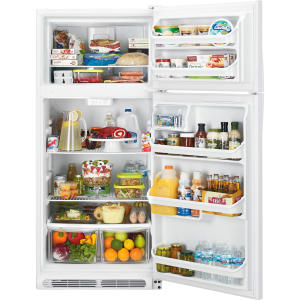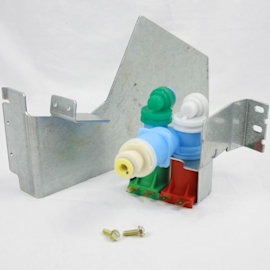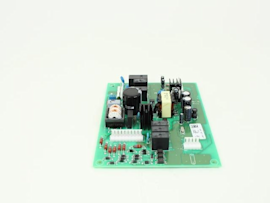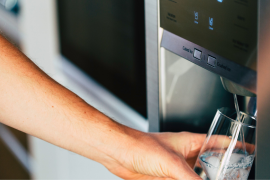How to get rid of refrigerator puddles


A puddle under the crisper drawers at the bottom of your top-freezer refrigerator usually means that water in the drain tube froze, blocking the path of water flowing from the evaporator coils to the drain pan under the refrigerator. The overflow from the evaporator coils makes its way through the refrigerator compartment, creating a puddle of water in the bottom of the fridge.
Thaw the drain path
To clear the ice jam so water drains again, follow these steps. Wear work gloves to protect your hands, because the evaporator coils are razor sharp.
Store food safely in a cooler or second refrigerator and then unplug the refrigerator.
Check how much water is in the refrigerator drain pan:
If the drain pan is under the refrigerator, pop the grille off the front bottom of the refrigerator. Leave the grille off so you can check the pan for overflow. Wipe up overflow water in the bottom of the fridge to prevent floor damage.
If the drain pan is next to the compressor, pull the refrigerator away from the wall and remove the exterior back panel. Leave the back open so you can check the pan later.
Inside the freezer compartment, remove the back panel to access the evaporator coils and drip tray below them.
Remove the ice from the drip tray. You then should see the hole to the drain tube, plugged with ice.
To thaw the drain tube, do one of the following:
Leave the freezer door open and wait for the ice in the tube to melt. Melting could take up to 10 hours, depending on room temperature, the amount of ice formed and other factors.
Clear the drain hole with hot water. Work hot water into the drain hole, wipe away the excess water, wait a few minutes for the ice to melt and then work more hot water into the drain hole. If the ice is deep, this method can take a few hours.
To verify that the drain tube is clear and water is draining, check the drain pan under the refrigerator again. It should be full of water.
Warning: Don’t pick at the ice with a knife, screwdriver or other metal tool. You could puncture a coil, releasing refrigerant.
Preventing the drain tube from freezing
Now that the drain is clean, take these steps to avoid the problem.
Open the refrigerator and freezer doors as seldom as possible, and close them as soon as you take out what you need. Make sure the door is completely shut; don’t trust the door to close itself after you give it a hip bump.
Store food and beverages in covered containers or sealed plastic bags. It helps minimize the humidity inside the refrigerator, and your food stays moist and doesn’t pick up odors.
Don’t wash fruit and vegetables before putting them in the crisper; they stay fresh longer if stored dry and don’t add to the moisture problem. If you must give them a quick rinse to remove garden dirt, dry them off before refrigerating.
Most common symptoms to help you fix your refrigerators
Choose a symptom to see related refrigerator repairs.
Main causes: control board or cold control failure, broken compressor start relay, compressor motor failure, defrost tim…
Main causes: jammed ice cubes, broken ice maker assembly, dirty water filter, kinked water line, bad water valve, freeze…
Main causes: water valve leaking, frozen or broken defrost drain tube, overflowing drain pan, cracked water system tubin…
Main causes: damaged door seal, faulty defrost sensor or bi-metal thermostat, broken defrost heater, bad defrost timer o…
Main causes: blocked vents, defrost system problems, evaporator fan failure, dirty condenser coils, bad sensors, condens…
Main causes: blocked air vents, compressor problems, condenser or evaporator fan not working, control system failure, se…
Main causes: leaky door gasket, defrost system failure, evaporator fan not running, dirty condenser coils, condenser fan…
Things to do: clean condenser coils, replace the water filter, clean the interior, adjust doors to prevent air leaks, cl…
Most common repair guides to help fix your refrigerators
These step-by-step repair guides will help you safely fix what’s broken on your refrigerator.

How to replace a refrigerator water valve
Replace the water valve that feeds water to the ice maker and water dispenser if it no longer controls the flow of water…

How to clean refrigerator condenser coils
Help your refrigerator run more efficiently by cleaning the condenser coils. It's easy and takes just a few minutes.…

How to replace a refrigerator temperature control board
If the temperature in your refrigerator doesn't match the temperature you set, the problem could be the temperature cont…
Effective articles & videos to help repair your refrigerators
Use the advice and tips in these articles and videos to get the most out of your refrigerator.

No matter what style Maytag refrigerator you have, we can walk you through replacing the water filter.…

Learn about all the convenient features on our Sears PartsDirect website that make your parts purchases easier.…

Get tips and advice on replacing the water filter in your LG refrigerator.…
